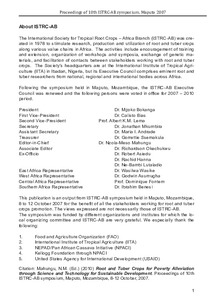| dc.identifier.citation | Njukwe,E., Amah, D., Ndango, R., Tenkouano, A. & Asiedu, R. (2010). Introduction and evaluation of improved varieties of Dioscorea rotundata, and D. cayenensis with high micronutrient content in Cameroon. In: Proceedings of 10th ISTRC-AB symposium in Mozambique: root and tuber crops for poverty alleviation through science and technology for sustainable development (p.338-342), 8-12 October, Maputo. |
| dc.description.abstract | Yam (Dioscorea sp.) is an extremely important delicacy in Cameroon, with some estimated 45,215 hectares devoted to it, and corresponding annual production of 275,101 metric tons. Production is constrained by several factors including the limited availability and cost of planting material, as well as susceptibility to a range of pests and diseases that cause considerable pre- and post- harvest losses, translated into low yields and poor quality of tubers during storage. With the development of new genotypes of yams through seed hybridization by the International Institute of Tropical Agriculture (IITA), new materials are being made available both in seed and tissue culture form for evaluation. In 2004, this scheme was extended to Cameroon, whereby fifteen D. rotundata and two D. cayenensis varieties were introduced for evaluation and selection at Mbalmayo (3o 25N latitude, 11o 28E longitude and 640 masl). They were planted in two blocks of equal number of seeds per variety spaced 1 x 1m, 1 x 0.5m and 1 x 0.25m for ware yams, seed yams and seeds for seed yams respectively. Data collected included reaction to anthracnose, yam virus, yield and tuber characteristics and micronutrient content. One D. cayenensis variety (TDc 98-136) and nine D. rotundata varieties (TDr Dente, TDr Muchumundu, TDr 95/19156, TDr 95/18531, TDr 95/18988, TDr 95/19127, TDr 93-83, TDr 89/02565, TDr 95/19177) were selected with farmers for further evaluation. Thus, uniform yield trials consisting of replicated large plots of each of the selected varieties were established at Mbalmayo and in farmers’ fields at Nkometou, Ombessa and Bamenda in collaboration with NGOs. Five varieties TDc 98-136, TDr Dente, TDr 95/18531, TDr 95/19158 and TDr 95/19156 were reported as best with high yield and post-harvest qualities. These varieties are currently under fast-track multiplication and distribution to farmers in seven provinces. In same vein, new varieties are introduced annually for on-station and on-farm participatory trials. |

